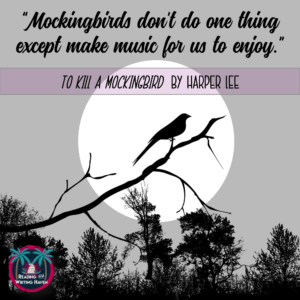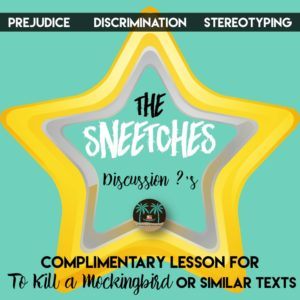6 Must-Teach Novels in Secondary ELA
A book is a dream that you hold in your hands. ~ Neil Gaiman
March is National Reading month, one of my favorites! Not only is the dreary winter weather starting to melt away, but we also have an excuse to share our love of reading with students every single day….it’s a thirty-one-day celebration. In today’s post, I’m sharing my favorite whole-class novels to teach in the secondary classroom. Even though the pendulum is swinging toward choice reading, whole-class, classic novels still deserve a place in most curriculums. After reading about my three recommendations, you can hop on over to the Language Arts Classroom to get inspired by three more of the best books to teach teens. Enjoy!
To Kill a Mockingbird
Overview: A timeless coming-of-age story told through the eyes of Scout, a six-year-old girl who lives in a fictional town in Alabama in the 1930s. The novel explores issues of racism, prejudice, innocence, and morality.
Why I like it: It’s such a unique classic that can be taught from countless angles with a focus on any number of literary elements. The way Harper Lee views the events of Maycomb county through Scout’s innocent six-year-old eyes is brilliant. Every time I read this novel with students, we peel away deeper layers of meaning. Although the story itself is somber, we all walk away from the novel feeling a greater sense of empathy and compassion for our neighbors.
Favorite lesson: I love introducing the concepts of stereotyping, prejudice, and bias through an anticipatory set that uses Dr. Seuss’s “The Sneetches.” Usually, my students have heard of these terms, but they can’t necessarily define them. Issues of equality and discrimination are widespread in today’s society, so one of my goals with the novel is to focus on the motif of the mockingbird and how those characters help to develop an overall theme of acceptance and compassion.
Favorite moment: I love seeing the question in students’ eyes when they finally realize Scout is a girl. She does an amazing job of defying gender stereotypes. Priceless!
Lord of the Flies
Overview: A group of school children crash on a deserted island during WWII, and without the restraining code of civilization, their innate barbarity begins to emerge.
Why I like it: This novel focuses on the true, dark, inner nature of humans. Without rules and society, who would we really be…savages? While the characters are young boys, William Golding has a way of making their experience on the island applicable and interesting to readers of all ages. Because the plot is similar to other stories and texts (the show Survivor, the book Hatchet, and the movie Castaway just to name a few), it’s fun to make connections as we read. Plus, the author omits just enough details to create a suspenseful, eerie mood while forcing readers to make sense out of details and fill in the gaps of meaning for themselves.
Favorite lesson: I’ve taught this novel with both seniors and sophomores, and at each level, I’ve implemented versions of a survivor simulation. The details change every year, but students enjoy the competition of voting people off their team in an effort to crown an ultimate survivor at the end of the novel. Many of the emotions the students feel throughout the simulation mirror those the characters experience in the book. The options for engaging students kinesthetically and creatively as well as for using STEM challenges are endless with this game.
Favorite moment: When students reach the part where Simon dies…the confusion and frustration on their face is clear. It leads to deep discussions about whether or not humans would still be civilized without the rules of a society.
You can find my free Castaway analytical comparison tool here.
The Odyssey: A Graphic Novel
Overview: This graphic novel by Gareth Hinds puts a modern twist on Homer’s epic poem that details the voyage of Odysseus and his comrades as they sail across the Aegean Sea on their way home from the Trojan War. The ten-year voyage is full of danger and obstacles both for Odysseus and his crew as well as for his family at home in Ithaca.
Why I like it: What English teacher doesn’t love a classic epic poem? Mythology is always interesting, but the dry nature of the original verse can sometimes be wearing both on students and teachers. This book doesn’t leave out any important details. In fact, it makes the 24 book poem accessible to a wide age range and ability level of readers. To my surprise, many of my freshmen students had never read a graphic novel before exploring this one. Even enriched students who can handle the full epic poem were challenged by learning how to read a new type of text. Using the graphic novel version can be a whole class strategy, but it can also be a way to differentiate for a variety of learners.
Favorite lesson: Mythology is a genre of literature that many students are truly interested in, and why wouldn’t they be when fun, relevant myths are available even to young readers? To tap into students’ existing knowledge and allow them to delve deeper into specific stories and characters that interest them, I always begin my mythology unit with a background information presentation that lends itself well to discussion. Following, students complete group research presentations about characters, stories, and allusions to the most well-known myths.
Favorite moment: Students, even those reluctant to mythology, love reading about Scylla and Charybdis and the Cyclops, Polyphemus. We draw a map on the board of all the obstacles Odysseus encounters, and the students dive into meaningful discussion as they try to recap and sequence the events from the story.
Ready to read about three more of our favorite novels and activities to share with secondary students? Please share your favorite novels to use in the secondary classroom below! We’d love to hear from you.
RELATED RESOURCE:
Click on the image below to view this engaging discussion-based assignment I like to use when I introduce To Kill a Mockingbird.




